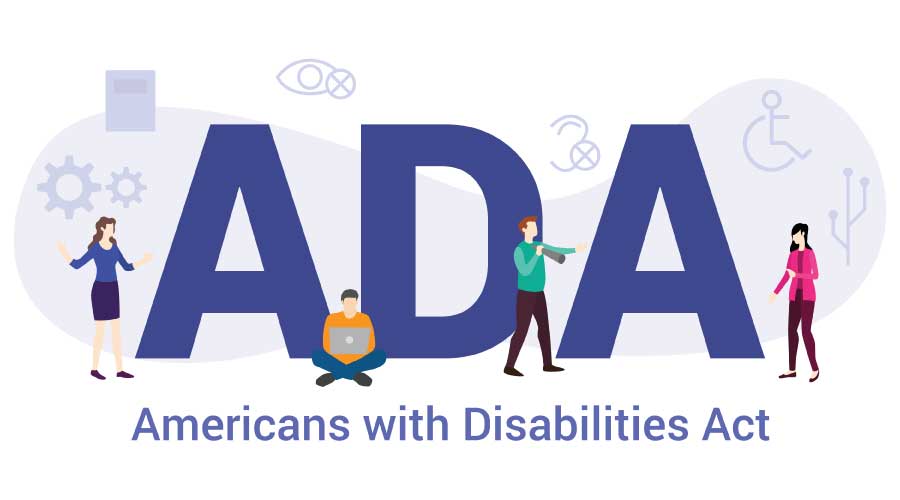Avoiding ADA Lawsuits
Today, 18 years after the Americans with Disabilities Act (ADA) was signed into law, a significant number of facilities covered under this federal law are still being sued for their failure to comply with the standards. A recent report generated by Lexis Nexis documented 204 private ADA lawsuits filed in the federal courts in the month of July 2008 alone. This total does not include cases that are being investigated or litigated by the U.S. Department of Justice (DOJ), the federal agency responsible for enforcement of Titles II and III of ADA.
Why is there so much litigation so long after the law took effect? The answer to that question lies is the basic principles of ADA.
- ADA is a complaint-driven law. Although DOJ initiates some investigations, most complaints are generated by individuals with disabilities, their families or disability-rights organizations. Additionally, private lawsuits (the 204 in July 2008, for instance) can be filed directly in federal courts by those who believe their civil rights have been violated. Unlike other federal regulations, ADA does not have an “inspection” mechanism like the Occupational Safety and Health Administration. It relies on entities to comply with the requirements proactively.
- Many believe the myth that any building built before ADA became law in 1990 is “grandfathered” in. In reality, for buildings built before ADA, facility executives were required as of Jan. 26, 1992, to begin removing barriers and working toward compliance. This process is ongoing. These activities may well come before what organizations plan for in renovations or alterations. They include items such as installing a ramp to an entrance, widening doors, enlarging toilet stalls and installing grab bars, etc.
- Many design professionals look at ADA as a building code. It is actually a civil rights law. There are substantive differences between building codes and ADA requirements. What’s more, building inspectors and other officials review and sign off on plans using the International Building Code (IBC) and its technical standards, ANSI. Design professionals believe a project is compliant because plans have been approved. In reality, that assumption often leads to ADA issues that can result in a federal lawsuit. Problems can start with something as seemingly minor as lack of accessible parking (including access aisle and signage), to more serious issues of restrooms, sleeping rooms (hotels and residence halls in higher education), hospital patient rooms and bathing facilities.
- Many organizations have taken the “I’m not going to do anything until I have to” approach. This single strategy has been the cause of many lawsuits.
So Sue Me
Newspaper articles report complaints about shopping centers, movie theatres, private and public post-secondary educational institutions, restaurants and retail stores. The complaints range from “no accessible parking” to “no accessible restrooms in a restaurant.” The cases range from existing facilities that have not performed “readily-achievable barrier removal” to those that have designed and constructed new facilities (following implementation of ADA) that do not comply with ADA requirements. Disability advocates say that 16 years is long enough — or too long — to wait for access.
When faced with a private lawsuit, it is important to determine whether the allegations are valid. The first step is having a professional ADA evaluation by an organization that understands the differences between building code and enforceable ADA standards.
A side-by-side comparison of the allegations of the complaint and these professional findings is often helpful. If the issues focus on barriers that can be removed (providing compliant parking, re-surfacing sidewalks and curb ramps, etc.), this can help to speed the resolution of the complaint without tremendous time, attention or cost of a legal team. On the other hand, if the professional evaluation provides evidence that areas identified in the complaint are in compliance with ADA, the facility executive has critical information that can be used to negotiate.
A professional ADA evaluation should also include the steps necessary to bring the facility into compliance. For example, whether an item is readily achievable is based on the organization’s resources and the nature of the existing building. If facility executives have not yet done a full ADA evaluation, this report serves as a crucial step in ADA compliance efforts. By following through with the recommendations, with a timeline and budget delineated, a facility executive can often prevent subsequent ADA complaints.
Although the DOJ engages professionals to perform on-site investigations, it is still important for facility executives to have their own set of facts available to assist in any negotiations with the DOJ. The DOJ may also see the effort to perform a complete ADA evaluation as a positive step.
Minimizing Risk of Litigation
How can facility executives avoid ADA litigation? Truthfully, nothing can guarantee that an organization will not be sued under the ADA. But doing nothing certainly increases the odds of getting sued. When a complaint is filed (either in court or with DOJ), facility executives may not have control over the barrier removal process; it may well be dictated by the courts or DOJ.
Taking proactive steps now will help keep facility executives ahead of that curve. Here are some such steps:
1. If a facility executive performed a comprehensive ADA evaluation of a building previously, that’s good. Now it’s time to take it off the shelf, read it and ask the following questions:
- Have “readily achievable” barriers been identified and removed?
- Were these changes documented in the ADA compliance plan?
- Was a plan developed to address barriers requiring capital expenditures?
- Is that plan being followed?
- Are all renovations, alterations and new construction required to comply fully with ADA requirements? Was this requirement specifically stated in contracts for all professional services, including architects, engineers and contractors?
- Does the organization ensure that all accessible elements (elevators, automatic door openers, wheelchair lifts, visual strobe alarms) are maintained in working order?
If there are more “no” answers than “yes,” it’s time to get to work.
2. If a comprehensive ADA evaluation of the facility has not been performed, now is the time to do it. Having an outside professional perform the evaluation provides a second set of eyes and professional experience in ADA compliance. The survey process should include:
- An on-site evaluation and report based on the enforceable ADA Standards (not the proposed 2004 Guidelines or IBC). The evaluation should include the exterior of the property, including path of travel from the street, public transportation, parking and sidewalks. The interior review should include all areas accessed by visitors, customers or vendors.
- Recommendations for how the barriers can be removed. Not all barrier removal requires full demolition and reconstruction. Look for answers that address policies, procedures and creative approaches to barrier removal. Photo documentation should be an integral component of the report.
- Use the information and recommendations as the basis for an ADA compliance plan. Add critical information such as resources necessary (including financial and human) to make the modifications, projected timeframes for completion, and remedial steps that might be needed until full accessibility can be accomplished. This plan should be integrated into the organization’s financial, construction and strategic plans.
- If design professionals are engaged for the remedial steps, ensure that they are familiar with and understand the requirements of the enforceable ADA standards. Make that a provision in the standard contract language.
- It’s often helpful to get an ADA consultant to review the design documents before they are completed and turned over to the construction team. This can ensure full compliance with ADA standards.
- Document all changes with photos and measurements.
- Consider bringing the ADA consultant back to evaluate renovations or new construction projects during punch-list time. Often there are gaps between what may be designed to be compliant, and what the end result is. This “contract warranty review” provides critical information regarding any non-compliant items. The information will direct facility executives to the person who will be responsible for remedying the “errors or omissions,” the design professional or the contractor, in accordance with the contract language.
Some facility executives wonder why they have to do this. There are several reasons. The biggest one is simple: It’s federal law. If an organization that is not in compliance with ADA has not been sued yet, it may be only a matter of time. ADA is not going away.
According to the U.S. Department of Labor, people with disabilities have $175 billion in discretionary income, four times the spending power of tweens (8- to 14-year-olds). An Open Doors Organization study estimated in 2003 that diners with disabilities spent $35 billion in restaurants that year. As baby boomers age, more and more seniors will become disabled as ailments and the natural course of aging challenge their bodies. They will seek out level entrances, wide automatic doors and single-level living as they try to avoid stairs and revolving doors. Surprisingly, families with young children also seek these features. Given that all these people with money are looking for easy access to the businesses they patronize, the market is beginning to change. Making commercial enterprises accessible to people with disabilities is smart business.
Joan W. Stein is president and CEO of ADA, Inc., a national ADA consulting firm based in Pittsburgh, PA.
Related Topics:









